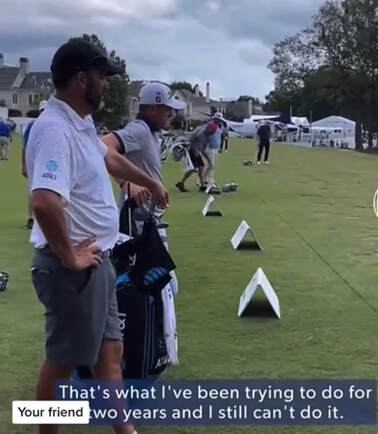Challenging Stereotypes: Lexi Thompson's Performance Highlights the 'Gender Gap' in Elite Golf14/10/2023 In the world of professional golf, the margins between success and disappointment can be razor-thin. Lexi Thompson's recent experience at the Shriners Children's Open serves as a stark reminder of just how demanding this sport can be, and the discussions it has sparked about the so-called 'gender gap' in elite sports are more pertinent than ever. At this week's Shriners Children's Open, Lexi Thompson, one of the most accomplished female golfers, missed the cut by a mere three strokes. While the golfing world watched with bated breath, hoping to see her advance to the weekend rounds, Thompson's performance underlines a topic that frequently resurfaces in the realm of professional sports – the physical differences between male and female athletes. Lexi Thompson's pursuit of making the cut at a PGA Tour event is not about transgressing the boundaries of gender-specific sports. It's about challenging herself and testing her skills against the world's top male golfers. As she said herself, "making the cut will be her biggest achievement in golf," and her determination to do so should be celebrated. However, Thompson's journey at the Shriners Children's Open also shines a light on the disparities in physical attributes and how they can impact performance at the elite level. The 'gender gap' debate is not limited to golf; it spans various sports, including tennis, where Serena Williams has shared her perspective. Williams, one of the most successful female tennis players in history, has acknowledged that at the elite level, men's physical advantages in terms of speed and strength could be insurmountable for female athletes. In golf, this 'gender gap' becomes particularly evident when assessing the performance of top female players against their male counterparts. Lexi Thompson's impressive display over two rounds, where she held her own and even outperformed some PGA Tour winners playing from the same tees, is a testament to her extraordinary talent and dedication. What becomes clear is that comparing elite women's golf to the average male golfer's game is like comparing apples to oranges. The notion that women's golf is "more realistic" for single-figure or scratch golfers couldn't be further from the truth. If you were to tee it up on an LPGA event as a male golfer with a 5 handicap or better, you would not only miss the cut but do so convincingly. The skill level required to compete at the highest level of women's golf is, without a doubt, world-class. The 'gender gap' in sports is a complex and multi-faceted issue, but it's essential to recognize that male and female athletes compete in different divisions based on a long history of performance disparities rooted in physical differences. Nonetheless, athletes like Lexi Thompson continue to break down these barriers, pushing the boundaries of what's possible in their respective sports. While the debate about gender differences in sports will undoubtedly continue, let's not forget to appreciate the incredible talent and dedication of athletes like Lexi Thompson. Her quest to make the cut at a PGA Tour event, although unfulfilled this time, serves as an inspiration for golfers of all genders, emphasizing that excellence knows no boundaries, and one's achievements should be measured by their determination and passion for the game.
1 Comment
Adding the element of the course with different lies, obstacles and the pressure of a scorecard, will have an effect on your swing. Tempo can change and will your technical work hold up under pressure? If you're struggling, a few changes might be needed. Here are the two biggest (often mistakes) I see: Warm Up You should be avoiding any technical thoughts, you're not trying to improve your golf now, you're trying to see where the ball is going today! Pre Shot and intent You should have a pre shot routine and usually any movement should be consistent and help produce the shot you want to hit. Over the ball there are options, do you think of a position? The ball flight? or nothing? This is as much of a skill as the swing itself so get practicing and see what works best. One of the biggest challenges that many amateur golfers face is achieving the level of consistency they want. Despite their best efforts, they struggle to maintain a steady performance on the course, which can be frustrating and demotivating.
It's important to note that amateurs are not completely inconsistent, but rather their level of consistency may not meet their high expectations. Often, amateurs have unrealistic expectations for their performance, which can lead to disappointment and frustration. They may compare their game to professional players or higher-skilled amateurs, which can set them up for disappointment. Nine out of ten times its the reason we hear players want lessons in the first place. There are several reasons why amateurs struggle with consistency in golf. Top of the list, many amateurs lack a technique that helps an efficient and consistent delivery at impact, usually causing an inconsistency in the club face and strike. This would require an improvement technically, or an extremely high skill level which most amateurs wont posses as not enough time to practice. If you're new to the game, get lessons in early to understand some basics and how YOU can best deliver the club. For those that have been around a while, if consistency is still an issue, you need to raise you skill level while working on a mote efficient technique. More to come on this but check out the video below for a consistency issue we often see! TASK BASED LEARNING
Task-based learning is an approach to teaching and learning that focuses on developing practical skills through real-world tasks or challenges. In golf, task-based learning can be particularly advantageous because it allows golfers to develop their skills in a more natural and realistic way, rather than just practicing drills and exercises. One advantage of task-based learning in golf is that it helps golfers develop their problem-solving skills. Golf is a game that requires constant adjustments and adaptations based on the conditions of the course and the shot at hand. By practicing real-world tasks or challenges, golfers can develop their ability to make quick decisions and adjustments based on the conditions they are facing. Another advantage is that it helps golfers develop their feel for the game. Golf is a game that requires a certain level of touch, feel, and finesse, particularly when it comes to putting and short game shots. By practicing tasks that require precise control and feel, golfers can develop their ability to judge distances and control their shots with greater accuracy. Finally, it can also be more engaging and enjoyable than traditional practice methods. By practicing tasks that are challenging and meaningful, golfers can stay motivated and focused on their goals, rather than just going through the motions of a practice session. You'll practice longer with a deliberate focus receiving meaningful feedback each shot. During this (or any practice), you're expecting to hit a bad shot (relative to your ability) once every eight shots. If its more than that the task is too hard, less than that, its too easy and limited learning will take place. Find the 'Goldilocks zone' for you! Overall, task-based learning is an effective way to develop practical skills in golf and can help golfers improve their decision-making abilities, feel for the game, and overall enjoyment of the sport. Well, as you're on my website and maybe looking for lessons, then I hope you think they do or would! However, only 15% of golfers (players that play once per month) actually have lessons. Why? The top reason, before affordability, time etc is... most people think you'll go backwards before you go forwards. This is a myth, worst case scenario after one lesson is you'll leave with a better understanding of how to improve. On almost every occasion, players will leave a lesson with an improvement in ball flight, strike etc. What happens next however, is the reason players believe lessons don't work... If from a 60 minute lesson, you think a technical change will stick when you play on the course the following day, it wont. You'll go back to default. Depending how that round goes I'll get one of the following messages... "Oli, changes worked great! shot the lowest round of the year so far!" or "Implemented the changes from the lesson on the course and it wasn't working." or BOTH!.... "Thanks again for the lesson, really enjoyed it and looking forward to starting the programme. I played a round Friday that went really well! Then again Sunday which was awful!" In both situations, 99% of the time there would have been no change in the swing technically. What can change instantly; decision making, expectations, understanding. All of which would improve your scores. The technical changes usually take longer. Interviewer: So what have you been working on with Colin (Morikawa)? Rick Sessinghaus (coach): Well, kinda the same thing for the last 3 years 3 years! Best ball striker in the world is still working on technical improvements. Check out JTs comment below! So when you see coaches (including myself), post 'before and after' swings from the same lesson. Even if this isn't a drill, its been done in a very sterile environment, not the course in an event. Big difference!
Technical changes take time! But, there is some good news! While working on technical changes, you can develop other parts of your game to improve! SKILL Lessons and practice (when competent) should include an aspect of skill development. Improving your skill can also help change technique and if this is a change in technique that was created by the player, it's usually a quicker change that will last longer. GAME MANAGEMENT AND EXPECTATIONS Most players would instantly save shots if they were realistic with yardages and accepted their miss. Measure your practice and dont assume you'll hit your best 150 yards baby fade with your 7 iron each shot. Remember, you've also got a 120 weak slice as part of your shot pattern. So yes, lessons do work but they should include skill development, game management as well as just drills for technical changes. Regular feedback between coach and player is also crucial to help ensure nothing slips back to default. This can be done online between lessons and if you're down at Tee Box, all your practice is recorded! Lesson programmes work, one off quick tips don't. What’s your go to club after a quick warm up on the range? 7 iron?
Are you one of those who likes to ‘work your way though the bag'?’ Training well should be easier than ever these days. Lots of technology available on the range to test and measure your skills. However, if you don’t know what to work on, how will you improve? Monitoring your progress on and off the course will save you so many shots! To get started, I’ve recommended the TaylorMade My Round Pro App and Arccos. However, if you’d like to take part in a free trial on a new app, click here In the meantime, here is an example of how you can use your lessons and stats to start to train better! Tee Box London - Leadenhall . NOW OPEN
The biggest indoor centre in the city complete with 10 Trackman 4 bays and a zen putting green to come. Want to check out the impressive new venue? Click here for a free swing evaluation Been a loads of great golf to start the year on the @europeantouretd . @tyrrellhatton didn’t have the best time on the 18th at @yaslinksad in a couple of rounds.
Safe to say the entertaining, out-spoken Tyrrell was going to share his thoughts… “It must be one of the worst par 5s that I’ve ever seen in my life and, over the last two days, I’ve clearly played it about as well as it was designed,” Hatton said on Saturday. “What’s wrong with it? Where do you start? It shouldn’t have a bunker in the middle of the fairway, and it shouldn’t be over 600 yards from a forward tee. If you hit a good drive as a pro you should have at least a chance to go for the green in two, otherwise the hole becomes a par 3 and that’s if you play it well.” “That I would love for a bomb to drop on it and blow it up to oblivion to be honest,” he said. “It's just such a terrible finishing hole. And the fact that they moved the tee back today is ridiculous. I hit a really good tee shot and still got 290 front. I could peg-up driver up and still not get there. It would be a much better finishing hole if you're actually rewarded for hitting the fairway, which as it stands, you're not.” What's the worst hole you've played? Is there a better sight than this on the golf course?! Tiger Woods swinging a club again! If he does make another comeback, that will be some ticket to have! When he does finally leave the game though, is there another player that will have an impact close to Tiger? Bryson is changing the game in is own way and Rory may be finding some form and showing some passion. But will anyone have the same impact as Tiger?
You may know some of his obvious career achievements, but here are my favourite lesser know but still as ridiculous stats:
I said this in Rio and Justin Rose certainly agreed, Golf is great for the olympics!
Rory 5 years ago in my opinion didn't help the game, and although not going for health concerns could have said more about the inclusion. Different story in Tokyo! An amazing field and Xander winning by one shot with a special olmpic story to go with it! Then a 7 way play off for the bronze! Has 3rd place every mattered so much to a golfer? Not only that, 7 different nationalities all completing for that last medal! Exactly what the olympics is all about! However... is stroke play over 4 days really the best format? Perfect opportunity for a match play team event! There's the world cup of golf but is that even close to the same level of excitement as the Ryder Cup? No. The Olympics could be! As much as I wanted Casey and Fleetwood to bring a medal back. It still didn't feel like a team event. Surely more players in a knockout format would increase the excitement for spectators and keep teams / players in with a medal chance for longer. Hope Paris get it right for the next one and golf continues to grow worldwide! Coaching online with Skillest has really shown how the game has kept growing over this pandemic and with online learning players and coaches can work together from anywhere. |
AuthorOli Tucker Archives
October 2023
Categories |







 RSS Feed
RSS Feed